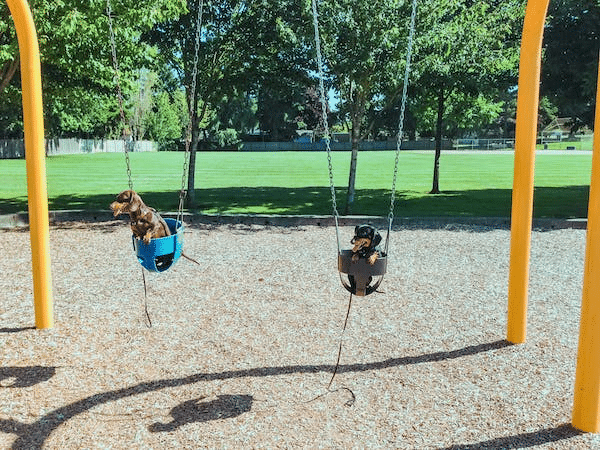Dog parks have become increasingly popular over the past few years, as many pet parents see them as a way to give their furry friends some off-leash time to socialize and exercise. However, there are both pros and cons to taking your four legged friends to a dog park. In this blog post, we’ll take an honest look at the pros and cons of dog parks, so you can make an informed decision on whether or not this is a good choice for you and your furry friend.

Pros of Dog Parks:
Great opportunity for socialization
Dog parks offer an excellent opportunity for dogs to socialize with other dogs and their owners. Pets are social animals, and dog parks can provide a place where owners can watch their furry friends play and interact with other dogs of various breeds and ages. This socialization can help to build a dog’s confidence and teach them various social skills.
Good exercise
Dogs need exercise, and a dog park can provide an open area where they can get their much-needed exercise. Dog parks give dogs the space they need to run, jump, and play.
Better Pet-Owner Relationship
Dog parks provide an opportunity for pet owners to spend quality time with their dogs. When you take your dog to a dog park, you spend time watching them, playing with them, and doing things together. Dogs get to enjoy the outdoors, sniff new smells, and spend quality time with their best friend.

Cons of Dog Parks:
Disease and Parasites
A dog park can be a hygienic nightmare. Various pets come to the park, and some of them might have diseases or parasites that they can spread in the area. It is essential to keep your dogs away from mingling water sources, and always consult your vet before taking them to dog parks.
[divilifeshortcode id='7986']
Bullying and aggression
Dogs, like humans, have their bad days. Some dogs might experience aggressive behavior in a dog park, leading to bullying and dogfights. Keep an eye on your dog’s interactions with other dogs and always be ready to separate them if things get out of hand.
Behavioral Issues
Some bad habits, such as digging, excessive barking, and jumping onto people, can be acquired by dogs from other dogs they meet in dog parks. A dog that learns bad behaviors might revert to them when back home, which can be a big problem for its owner.

Different Types of Dog Parks You Should Know About
Taking your furry friend to a dog park can be a great way to let them have fun, exercise, and socialize with other dogs. However, dog parks aren’t created equal. There are different types of dog parks with varying amenities, features, and restrictions. Understanding the differences between them can help you choose the right one for your dog’s needs.
Public Dog Parks
The most common type of dog park is a public park that’s free and open to the public. These parks vary greatly in size, layout, and amenities. Some are huge and have separate areas for large and small dogs, water features, agility equipment, and benches. Others are smaller and only have a fenced area. While public dog parks are usually maintained by the city or local government, they can attract dogs with varying temperaments and health conditions. It’s important to monitor your dog’s interactions with other dogs at a public dog park and keep them up-to-date on their vaccinations.
Private Dog Parks
Private dog parks are typically membership-only parks that require an annual fee. These dog parks offer more exclusivity and are often less crowded and cleaner than public dog parks. They also usually have stricter rules and regulations for dog behavior and vaccinations. Private dog parks can also provide additional amenities such as communal water stations, separate areas for different dog sizes, and professional dog trainers. If you’re looking for a safer, less crowded, and more exclusive dog park experience, a private dog park may be the right choice for you and your furry friend.
Doggy Daycare with Indoor and Outdoor Play Areas
Doggy daycare facilities are a popular option for dog owners who need to leave their pet for the day or a few hours. Many of these facilities have indoor and outdoor play areas that are designed for dogs to safely interact and exercise. Indoor play areas usually have padded flooring, toys, and dedicated staff to monitor dog behavior. Outdoor play areas are usually fenced and have multiple play structures, water stations, and artificial turf. Doggy daycare facilities can provide a fun and safe environment for dogs to play while their owners are away.
Dog Beaches
If you live near the coast, a dog beach can be a fun and refreshing place to take your dog. These parks usually have soft sand, clear water, and plenty of space for dogs to run and swim. Some beaches have specific dog-friendly sections, while others allow dogs to roam freely. However, dog beaches can be less structured and have fewer amenities than other types of dog parks. They can also be crowded and require additional preparation such as sunscreen, drinking water, and poop bags.
Veterinary Practice Dog Parks
Some veterinary practices have their own dog park as an added service for their clients. These parks are usually smaller than public dog parks and often have specific rules and regulations related to dog health and safety. They can also provide additional veterinary services such as nail clipping, vaccinations, and check-ups. While you may not choose to go to a veterinary dog park regularly, it can be a great option for dogs with special health needs or for owners who want a more controlled environment.

The Great Debate: Off-Leash Dog Park vs Leash Dog Park
Dog parks have become increasingly popular in recent years, providing a safe and secure environment for our furry friends to socialize and expend their energy. However, as a dog owner, it’s essential to consider the park’s rules and regulations, including whether it’s an off-leash or leash-required park.
Off-Leash Dog Parks
The off-leash dog park is a favorite among many dog owners, allowing their pups to run around and play freely. These parks typically have a large, enclosed area where your dog can socialize and exercise without being tethered to a leash. Off-leash parks encourage dogs to be active, promote mental stimulation, and allow them to interact with other dogs. However, not all dogs are well-mannered, and your dog can get into fights or misbehave in a crowded off-leash park. It’s crucial to ensure your dog has proper socialization skills and obedience training before allowing them to roam off-leash.
Leash Dog Parks
On the other hand, leash-required dog parks offer more control and safety for dog owners. These parks often have shorter trails or smaller play areas where owners can supervise their dog’s activities while keeping them on a leash. This option is the best choice for dogs who are not well-socialized with other dogs or strangers. Additionally, if your dog has a history of running away, aggressive behavior, or has other health issues, it’s best to stick to a leash-required park. The downside of a leash-required park is that your dog may feel restricted and unable to play as freely as they would in an off-leash park.
Interaction and Socialization
Both off-leash and leash-required dog parks offer opportunities for your dog to interact and socialize with other dogs. However, off-leash parks provide a more natural environment for dogs to run, play, and interact without limitations. The downside is that not all dogs have excellent social skills, leading to potential conflicts or accidents. Leash-required parks may feel less stimulating to your dog, but it provides a safer alternative to enjoying activities in a controlled environment.
Considerations for Choosing the Right Park
When choosing between an off-leash and leash-required dog park, it’s essential to consider your dog’s temperament, breed, and health factors. Suppose your dog has not undergone proper socialization training or has aggressive behavior tendencies. In that case, it’s best to stick to a leash-required park to ensure their safety and the safety of other dogs. However, if your dog is well-socialized and trained and enjoys running and playing freely, an off-leash park may provide a more natural and enjoyable environment.

Why You Should Consider Better Alternatives to Dog Parks
Dog parks can be great for socializing your furry friend, but they’re not always the best option for every dog. Whether your dog is shy, reactive, or just not a fan of the chaotic atmosphere, there are plenty of alternatives to dog parks that you may want to consider.
Private Playdates
For dogs who aren’t comfortable in a crowded, high-energy environment, private playdates with a trusted dog friend can be an excellent alternative. This way, your dog can have a chance to play and socialize in a quieter, one-on-one setting without all the chaos of the dog park. Plus, it’s a great opportunity to strengthen the bond between your dog and a friend they already know and love.
Hiking Trails
Taking your dog for a walk or hike on a scenic trail is not only great exercise for both of you but can also be a wonderful bonding experience. Just be sure to keep your dog on a leash and be aware of other hikers and wildlife on the trail. Many hiking trails also have designated dog-friendly areas where your pup can play, splash in the water or even have a picnic.
Doggy Day Care
For dogs who need a lot of socialization and exercise, doggy daycare can be a great option. Not only does it provide your pup with a safe and supervised environment to play and run around without being on leash, but it also gives them the opportunity to socialize with other dogs in a structured setting. Just make sure to do your research and choose a reputable, well-regulated facility.
Agility or Obedience Classes
For dogs who need a bit more structured activity, agility or obedience classes can be an excellent option. Not only do they provide mental and physical stimulation, but they also help to strengthen the bond between you and your dog. Plus, the skills and training your dog learns can help improve their behavior in other settings, such as public parks.
Pet-Friendly Cafes or Restaurants
If your dog is more of a laid-back pup and just enjoys being around people while you enjoy your cup of coffee or a meal, there are many pet-friendly cafes or restaurants where you and your dog can relax together. These establishments not only serve up delicious food but provide a great opportunity for you and your furry friend to get out of the house and enjoy each other’s company.

Kate’s K9 Pet Care
Are your furry friends in need of some new companionship? AtKate’s K9 Pet Care, we understand that socialization is important for the overall well-being of your canine friends. While taking your dog to their first dog park can seem great, dog parks can offer a great outlet for exercise and socialization, they can also be risky. That’s why we offer a variety of services that prioritize the health and happiness of your pets, large dogs and small dogs alike.
Our experienced team will ensure that your dogs are getting the exercise they need in a controlled environment that is tailored to their needs. Contact us today to learn how we can help give your canine companions the opportunity to socialize and exercise.

Conclusion
Dog parks offer a chance for bonding between dog owners, their pets, and other dog owners. Going to a dog park can be as much of a social experience for you as it is for your dog. However, as much fun and positive things come with dog parks, there are also downsides that should be considered. Before taking your furry friend to a dog park, it’s essential to weigh the pros and cons to make the best decision. Always make sure that your dog is up to date with their vaccinations, and you should practice proper hygiene before and after visiting a dog park. Remember, your dog’s safety and wellbeing come first, and with proper care, dog park visits can be an excellent addition to both their lives and yours.







